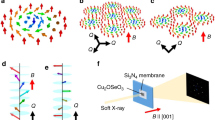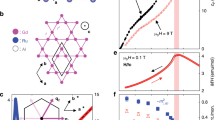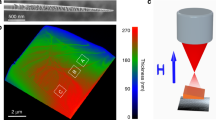Abstract
The phase transition most commonly observed is probably melting, a transition from ordered crystalline solids to disordered isotropic liquids. In three dimensions, melting is a single, first-order phase transition. In two-dimensional systems, however, theory predicts a general scenario of two continuous phase transitions separated by an intermediate, oriented liquid state, the so-called hexatic phase with short-range translational and quasi-long-range orientational orders. Such hexatic phases occur in colloidal systems, Wigner solids and liquid crystals, all composed of real-matter particles. In contrast, skyrmions are countable soliton configurations with non-trivial topology and these quasi-particles can form two-dimensional lattices. Here we show, by direct imaging with cryo-Lorentz transmission electron microscopy, that magnetic field variations can tune the phase of the skyrmion ensembles in Cu2OSeO3 from a two-dimensional solid through the long-speculated skyrmion hexatic phase to a liquid. The local spin order persists throughout the process. Remarkably, our quantitative analysis demonstrates that the aforementioned topological-defect-induced crystal melting scenario well describes the observed phase transitions.
This is a preview of subscription content, access via your institution
Access options
Access Nature and 54 other Nature Portfolio journals
Get Nature+, our best-value online-access subscription
$29.99 / 30 days
cancel any time
Subscribe to this journal
Receive 12 print issues and online access
$259.00 per year
only $21.58 per issue
Buy this article
- Purchase on Springer Link
- Instant access to full article PDF
Prices may be subject to local taxes which are calculated during checkout





Similar content being viewed by others
Data availability
The data that support the findings of this study are available from the corresponding authors upon reasonable request due to the huge volume (over a terabyte) of the raw data collected in this study.
Code availability
The computer codes that support the findings of this study are available from the corresponding authors upon reasonable request.
Change history
08 September 2020
An amendment to this paper has been published and can be accessed via a link at the top of the paper.
References
Mermin, N. D. & Wagner, H. Absence of ferromagnetism or antiferromagnetism in one- or two-dimensional isotropic Heisenberg models. Phys. Rev. Lett. 17, 1133–1136 (1966).
Mermin, N. D. Crystalline order in two dimensions. Phys. Rev. 176, 250–254 (1968).
Kosterlitz, J. M. & Thouless, D. Ordering, metastability and phase transitions in two-dimensional systems. J. Phys. C 6, 1181 (1973).
Kosterlitz, J. M. Kosterlitz–Thouless physics: a review of key issues. Rep. Prog. Phys. 79, 026001 (2016).
Berezinskii, V. L. Destruction of long-range order in one-dimensional and two-dimensional systems having a continuous symmetry group. I. Classical systems. Sov. Phys. JETP 32, 493–500 (1971).
Berezinskii, V. L. Destruction of long-range order in one-dimensional and two-dimensional systems possessing a continuous symmetry group. II. Quantum systems. Sov. Phys. JETP 34, 610 (1972).
Ryzhov, V. N., Tareyeva, E. E., Fomin, Y. D. & Tsiok, E. N. Berezinskii–Kosterlitz–Thouless transition and two-dimensional melting. Phys.-Usp 60, 857 (2017).
Halperin, B. I. & Nelson, D. R. Theory of two-dimensional melting. Phys. Rev. Lett. 41, 121–124 (1978); erratum 41, 519 (1978).
Nelson, D. R. & Halperin, B. I. Dislocation-mediated melting in two dimensions. Phys. Rev. B 19, 2457–2484 (1979).
Young, A. P. Melting and the vector Coulomb gas in two dimensions. Phys. Rev. B 19, 1855–1866 (1979).
Knighton, T. et al. Evidence of two-stage melting of Wigner solids. Phys. Rev. B 97, 085135 (2018).
Brock, J. D. et al. Orientational and positional order in a tilted hexatic liquid-crystal phase. Phys. Rev. Lett. 57, 98–101 (1986).
Cheng, M., Ho, J. T., Hui, S. W. & Pindak, R. Observation of two-dimensional hexatic behavior in free-standing liquid-crystal thin films. Phys. Rev. Lett. 61, 550–553 (1988).
Murray, C. A. & Van Winkle, D. H. Experimental observation of two-stage melting in a classical two-dimensional screened Coulomb system. Phys. Rev. Lett. 58, 1200–1203 (1987).
Kusner, R. E., Mann, J. A., Kerins, J. & Dahm, A. J. Two-stage melting of a two-dimensional collodial lattice with dipole interactions. Phys. Rev. Lett. 73, 3113–3116 (1994).
von Grünberg, H.-H., Keim, P. & Maret, G. in Soft Matter (eds Gompper, G. & Schick, M.) 41–86 (Wiley, 2007).
Mühlbauer, S. et al. Skyrmion lattice in a chiral magnet. Science 323, 915–919 (2009).
Yu, X. Z. et al. Real-space observation of a two-dimensional skyrmion crystal. Nature 465, 901–904 (2010).
Seki, S., Yu, X. Z., Ishiwata, S. & Tokura, Y. Observation of skyrmions in a multiferroic material. Science 336, 198–201 (2012).
Kézsmárki, I. et al. Néel-type skyrmion lattice with confined orientation in the polar magnetic semiconductor GaV4S8. Nat. Mater. 14, 1116–1122 (2015).
Skyrme, T. H. R. A unified field theory of mesons and baryons. Nucl. Phys. 31, 556–569 (1962).
Rößler, U. K., Bogdanov, A. N. & Pfleiderer, C. Spontaneous skyrmion ground states in magnetic metals. Nature 442, 797–801 (2006).
Wild, J. et al. Entropy-limited topological protection of skyrmions. Sci. Adv. 3, e1701704 (2017).
Han, J. H., Zang, J., Yang, Z., Park, J.-H. & Nagaosa, N. Skyrmion lattice in a two-dimensional chiral magnet. Phys. Rev. B 82, 094429 (2010).
Timm, C., Girvin, S. M. & Fertig, H. A. Skyrmion lattice melting in the quantum Hall system. Phys. Rev. B 58, 10634–10647 (1998).
Nishikawa, Y., Hukushima, K. & Krauth, W. Solid–liquid transition of skyrmions in a two-dimensional chiral magnet. Phys. Rev. B 99, 064435 (2019).
Adams, T. et al. Long-wavelength helimagnetic order and skyrmion lattice phase in Cu2OSeO3. Phys. Rev. Lett. 108, 237204 (2012).
Seki, S. et al. Formation and rotation of skyrmion crystal in the chiral-lattice insulator Cu2OSeO3. Phys. Rev. B 85, 220406 (2012).
White, J. S. et al. Electric-field-induced skyrmion distortion and giant lattice rotation in the magnetoelectric insulator Cu2OSeO3. Phys. Rev. Lett. 113, 107203 (2014).
Huang, P. et al. In situ electric field skyrmion creation in magnetoelectric Cu2OSeO3. Nano Lett. 18, 5167–5171 (2018).
Rajeswari, J. et al. Filming the formation and fluctuation of skyrmion domains by cryo-Lorentz transmission electron microscopy. Proc. Natl Acad. Sci. USA 112, 14212–14217 (2015).
Nelson, D. R., Rubinstein, M. & Spaepen, F. Order in two-dimensional binary random arrays. Philos. Mag. A 46, 105–126 (1982).
Bernard, E. P. & Krauth, W. Two-step melting in two dimensions: first-order liquid-hexatic transition. Phys. Rev. Lett. 107, 155704 (2011).
Zahn, K., Lenke, R. & Maret, G. Two-stage melting of paramagnetic colloidal crystals in two dimensions. Phys. Rev. Lett. 82, 2721–2724 (1999).
Guillamón, I. et al. Enhancement of long-range correlations in a 2D vortex lattice by an incommensurate 1D disorder potential. Nat. Phys. 10, 851–856 (2014).
Zahn, K. & Maret, G. Dynamic criteria for melting in two dimensions. Phys. Rev. Lett. 85, 3656–3659 (2000).
Beekman, A. J. et al. Dual gauge field theory of quantum liquid crystals in two dimensions. Phys. Rep. 683, 1–110 (2017).
Janson, O. et al. The quantum nature of skyrmions and half-skyrmions in Cu2OSeO3. Nat. Commun. 5, 5376 (2014).
Bergman, D., Alicea, J., Gull, E., Trebst, S. & Balents, L. Order-by-disorder and spiral spin-liquid in frustrated diamond-lattice antiferromagnets. Nat. Phys. 3, 487–491 (2007).
del Campo, A. & Zurek, W. H. Universality of phase transition dynamics: topological defects from symmetry breaking. Int. J. Mod. Phys. A 29, 1430018 (2014).
Deutschländer, S., Dillmann, P., Maret, G. & Keim, P. Kibble–Zurek mechanism in colloidal monolayers. Proc. Natl Acad. Sci. USA 112, 6925–6930 (2015).
Acknowledgements
We thank T. Giamarchi for very insightful discussions and J. White for estimating the longitudinal skyrmion correlation length in Cu2OSeO3 from small-angle neutron scattering data. We are grateful to D. Laub and B. Bártová for help with sample fabrication. This work was supported by the Swiss National Science Foundation (SNSF) through project 166298, the Sinergia network 171003 for Nanoskyrmionics and the National Center for Competence in Research 157956 on Molecular Ultrafast Science and Technology (NCCR MUST), as well as ERC project HERO. P.H. also acknowledges financial support from the Young Talent Support Plan of Xi’an Jiaotong University and the National Natural Science Foundation of China (project 11904277). L.H. and A.R. acknowledge financial support by the DFG within CRC1238 (C02) through project 277146847.
Author information
Authors and Affiliations
Contributions
P.H., F.C. and H.M.R. conceived the research. P.H. and M.C. designed the study. A.M. synthesized the crystalline samples. P.H., T.S. and M.C. fabricated the LTEM samples and performed the LTEM experiments. P.H., T.S., H.M.R. and F.C. analysed the data. L.H. and A.R. performed the micromagnetic simulations. All authors contributed to interpretation of the data. P.H., H.M.R., F.C. and T.S. wrote the paper with contributions from all authors.
Corresponding authors
Ethics declarations
Competing interests
The authors declare no competing interests.
Additional information
Publisher’s note Springer Nature remains neutral with regard to jurisdictional claims in published maps and institutional affiliations.
Extended data
Extended Data Fig. 1 Real space LTEM image of an area containing more than 30,000 skyrmions.
This implies the potential that much larger skyrmion systems can be achieved for the studies of collective behaviours in 2D compared to the conventional model systems.
Extended Data Fig. 2 Real space LTEM images and topology analysis of SkL at different magnetic fields.
a-d, LoG filtered LTEM images at H = 980 Oe, 1070 Oe, 1147 Oe, and 1160 Oe respectively. e-h, Voronoi diagrams corresponding to a-d respectively.
Extended Data Fig. 3 Pair distribution functions Gr(r) at different magnetic fields.
a,b, The solid phase. c–e, The hexatic phase. f,g, The liquid phase. The intensities are normalized.
Extended Data Fig. 4 Structure factor Sq(q) at different magnetic fields.
a,b, The solid phase. c–e, The hexatic phase. f,g, The liquid phase. The intensities are normalized.
Extended Data Fig. 5 Distribution of the orientational order parameter Ψ6(r).
a-c, Representative color maps derived from the distribution of Ψ6(r) at the solid (H = 667 Oe), the hexatic (H = 1108 Oe), and the liquid phase (H = 1203 Oe) respectively. The hue and the brightness of the color maps denote the phase angle and the amplitude of Ψ6(r) respectively, as illustrated by the inset in a. d-f, The corresponding Ψ6(r) distribution shown by arrows.
Extended Data Fig. 6 Distribution of topological defects in a skyrmion liquid.
a, Thin lines show the Delaunay triangulation, where each node indicates a skyrmion. Red and blue dots indicate respectively 5- and 7- sites. Unpaired 5-/7- sites are further labelled with a circle in the corresponding colors, whereas 5-7 pairs are connected with thick bonds. Defects with other coordinate numbers are indicated by green dots. b-d, Zoom-in of a 5-disclination, a dislocation and a 7-disclination respectively. Note the different numbers of lattice lines at the left and the right sides of the dislocation, as indicated by the light blue lines in c.
Extended Data Fig. 7 Skyrmion interaction potential in Cu2OSeO3 at different magnetic fields calculated by micromagnetic simulations.
The potential was calculated from simulations of a skyrmion lattice in a thin slab, see Supplementary Information for details. For larger magnetic fields the potential flattens considerably.
Extended Data Fig. 8 Summary of properties of skyrmion ensembles in different phases.
Real-space configurations, topology, Fourier transform, translational orders and orientational orders are summarized for the solid, the hexatic and the liquid phases respectively.
Extended Data Fig. 9 Melting hysteresis analysis at different magnetic field ramping rates.
a, Average orientational order parameter ∣Ψ6(r)∣ as a function of magnetic field at different field-ramping rates. The slow ramping rate at 3.3 Oe/s exhibits equilibrium behavior with negligible hysteresis, whereas higher ramping rates result in hysteresis. b and c show the real space distribution of domains at H = 1006 Oe when ramping the magnetic field up and down respectively at the rate of 113 Oe/s, as indicated by the dashed line in the bottom panel of a. The dramatically different distribution of domains fully illustrates the hysteresis in the melting process at a high field-ramping rate.
Extended Data Fig. 10 The SkL melting processes observed under different electron beam intensities.
η6 is the power-law decay exponent of the orientational correlation function G6(r) calculated from the real space SkL configurations throughout the melting process. The critical value of η6 → 1/4 is indicated in each panel by a line near the hexatic to liquid phase transition. Shaded areas are at the same magnetic fields as in Fig. 4 in the main text, indicating where the two transitions happen respectively. The results rule out the possibility of non-equilibrium behaviors induced by electron beam irradiation in our experiments.
Supplementary information
Supplementary Information
Supplementary Figs. 1 and 2, Discussion and refs. 1–5.
Rights and permissions
About this article
Cite this article
Huang, P., Schönenberger, T., Cantoni, M. et al. Melting of a skyrmion lattice to a skyrmion liquid via a hexatic phase. Nat. Nanotechnol. 15, 761–767 (2020). https://doi.org/10.1038/s41565-020-0716-3
Received:
Accepted:
Published:
Issue Date:
DOI: https://doi.org/10.1038/s41565-020-0716-3
This article is cited by
-
Motion and teleportation of polar bubbles in low-dimensional ferroelectrics
Nature Communications (2024)
-
Constructing coarse-grained skyrmion potentials from experimental data with Iterative Boltzmann Inversion
Communications Physics (2023)
-
Light-induced hexatic state in a layered quantum material
Nature Materials (2023)
-
Bloch points in nanostrips
Scientific Reports (2023)
-
Ordering of room-temperature magnetic skyrmions in a polar van der Waals magnet
Nature Communications (2023)



